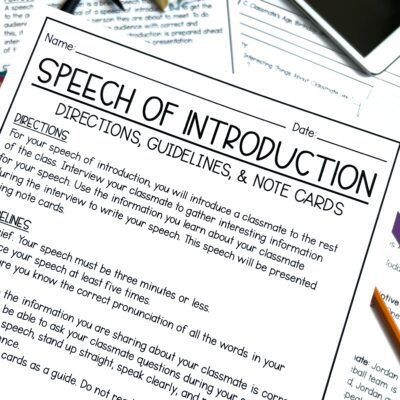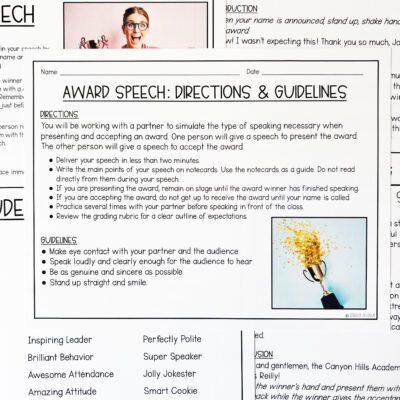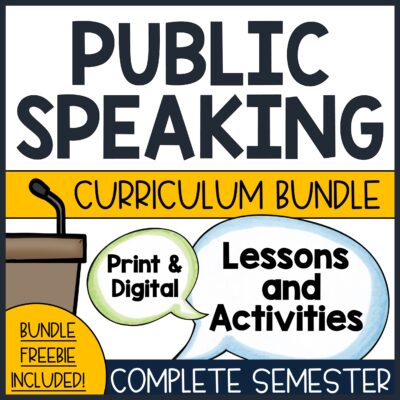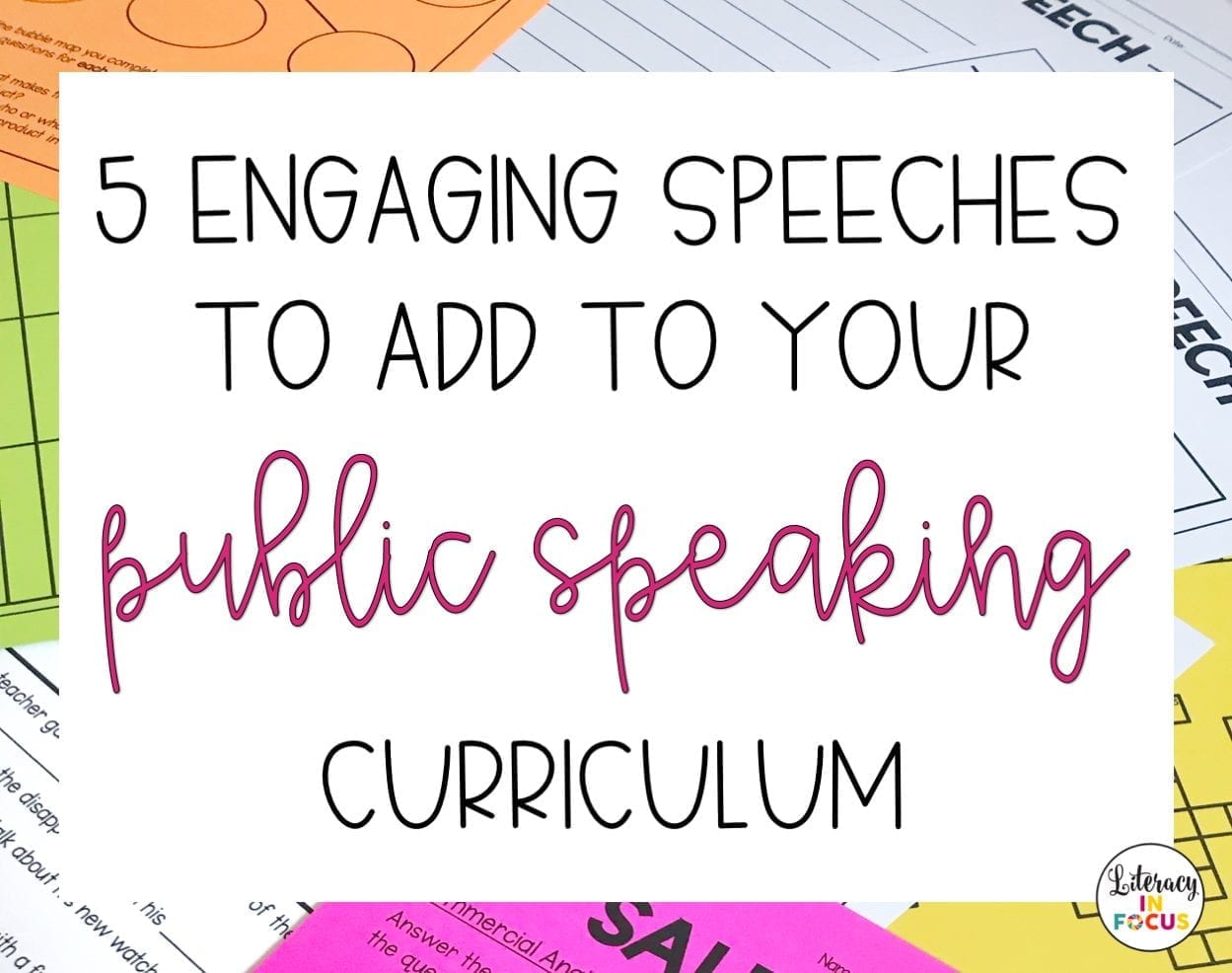
Most educators would agree that reading, writing, speaking, and listening are the four pillars of literacy. A strong foundation in each strand enables young learners to consistently grow over time. In order to develop all strands equally, it is important to incorporate activities and lessons for each skill set into your curriculum. While reading and writing will most likely form the backbone of your instruction, developing some anchor activities for speaking and listening will enable your students to move forward in their education with a stronger foundation from which they can continuously build. Incorporating different types of speeches, or oral presentations, is a fun and engaging way to add speaking and listening lessons to your curriculum. The built-in versatility of the five speeches detailed below make them great additions at any point in the school year.
Speech of Introduction
The Speech of Introduction works extremely well when used to kick off the new school year. It serves as an excellent ice breaker, giving students a chance to get to know each other in a fun and friendly way. Another benefit of the Speech of Introduction is that it teaches students how to speak effectively using notecards. Getting used to speaking from notecards is something that takes time to develop, and the Speech of Introduction is a great place to start! Before partnering students up to introduce one another to the class, it is important to review the speech prompt and guidelines. The prompt states the purpose of the speech, and the guidelines lay out all the necessary information students need before getting started. Next, students are ready to interview their classmates! It’s always best to pair students up in a way that allows them to move out of their comfort zone and possibly meet someone new. When students have been adequately paired, it is time for them to interview each other. I like to keep the interview as open ended as possible to keep the conversations flowing at a steady pace. After students have completed their interviews, they are ready to transfer the information to notecards. Each notecard is numbered and contains specific information they will relay to the class about their partner. Since this is the first speech of the year and students are learning to speak from notecards, it is important for students to explicitly follow the guidelines when setting up each card. It is also important to review the speech rubric with students, so they have a clear understanding of the speech expectations. Last, before students present their partners to the class, I make sure to remind them that they will be marked down for any comments or noises deemed inappropriate while others are speaking. Starting the year with the Speech of Introduction allows you to sneak in speaking and listening skills right off the bat. Plus, it gives students a chance to get to know their new classmates and learn a new skill at the same time!
Pet Peeve Speech
The Pet Peeve Speech is always a students favorite. It incorporates humor while further developing the skills required for public speaking. Like the Speech of Introduction, I start with the speech guidelines. The speech guidelines provide students with the meaning of a pet peeve and a brief overview of the speech and its requirements. When it’s clear that students understand the meaning of a pet peeve, we use a bubble map to brainstorm pet peeves together as a class. After students get the hang of it, they can fill in their bubble maps with pet peeves that are unique to them. Next, students are ready to outline their speeches. I provide them with two speech outlines. The first is a blank template that outlines the organization and flow of the pet peeve speech. The second outline provides students with an example speech. We read through both outlines as a class before students begin writing. Finally, we review the rubric to ensure all students have a clear understanding of the grading expectations and requirements for their pet peeve speech.
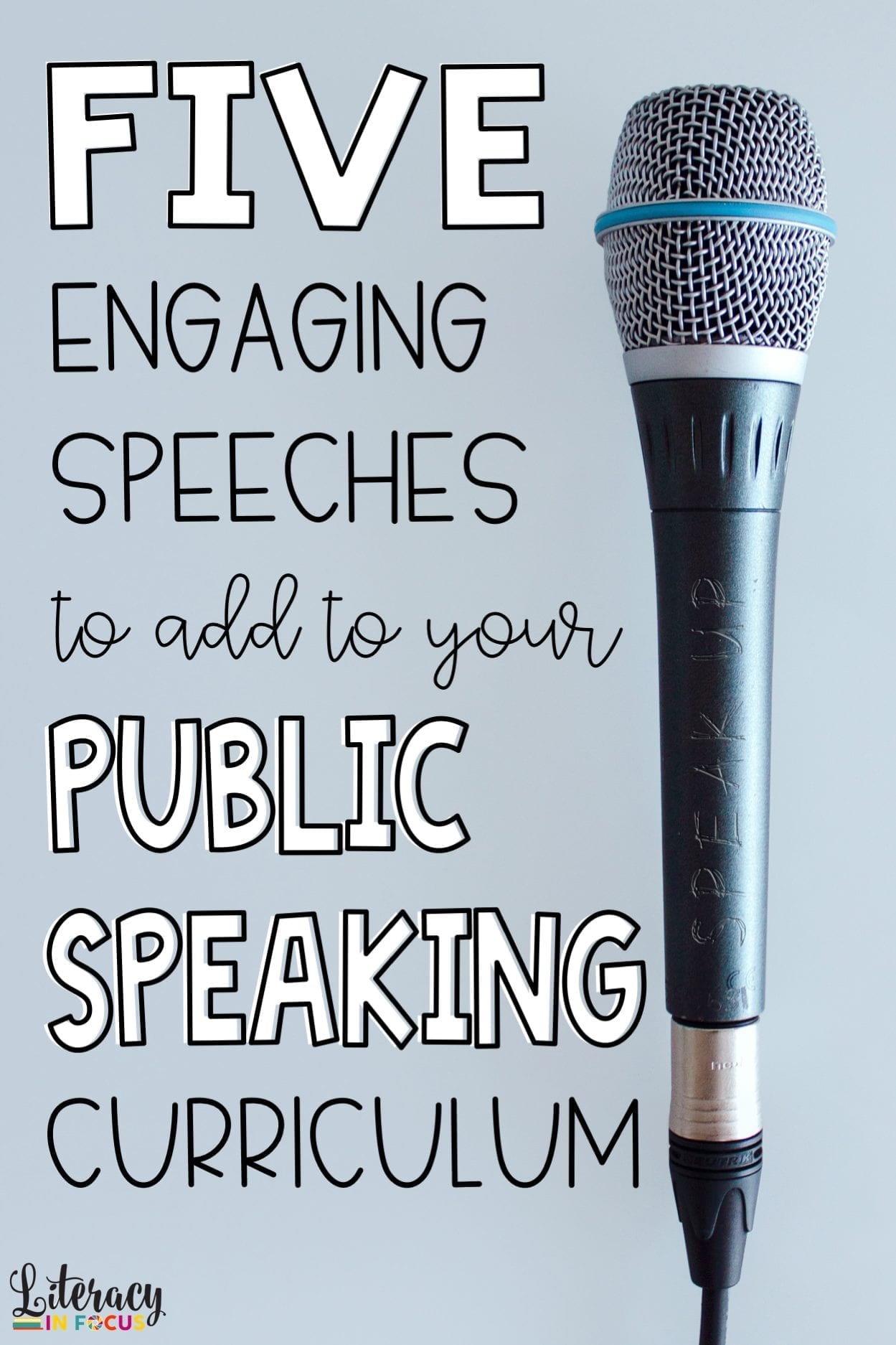
Sales Speech
One of my favorite student speeches is the Sales Speech. It gives students a chance to learn about marketing and speaking persuasively in order to sell a product to the class. Learning the Sales Speech vocabulary terms is the first step in presenting a successful speech. Students learn fourteen different terms related to sales and marketing. After defining all the terms, I have students complete a crossword puzzle to ensure understanding before being assessed on all of the words related to the Sales Speech. The next portion of the speech requires students to select a product to sell to the class. In order to choose the right product, students will complete two product brainstorms. The first brainstorm requires students to fill in a bubble map with ten possible products they could sell to the class. I like to let students know that they should be thinking about products that they can bring in to class to show or demonstrate in person. The second brainstorm requires students to narrow down their bubble map entries to three possible products. On a separate piece of paper, students answer six questions for each of their three possible products. Finally, students select one product they will sell to the class. When they have selected their product, and I have approved it, it is time for them to conduct their product survey. Students will interview three other people in order to learn more about marketing their products. At this point in the process, I like to take some time to discuss with students different aspects of sales and marketing. Last, we review the speech rubric together as a class, and students begin working on their speech outlines, preparing to successfully sell a product to their classmates.
Storybook Speech
The Storybook Speech teaches students about the art of oral interpretation. Students master voice inflection and characterization by reading a children’s book to the class. Again, like all of the other speeches, I start with the speech guidelines. I want to make sure students understand the meaning of an oral interpretation, and I provide them with a brief overview of the speech and its requirements. Next, we move on to the oral interpretation vocabulary terms. Students define the new terms, complete a crossword puzzle, and show mastery with an assessment. Before moving on to selecting a book to read to the class, I stress to students the importance of selecting a storybook that will allow them to stay within the three minute time limit. After selecting an appropriate book, students complete a book analysis. Completing the book analysis helps to familiarize students with the ins and outs of their book before they present the story to the class.
Award Speech
I like to end the year by teaching students how to appropriately present and receive an award. By this time in the year, students understand most of the general aspects of giving a speech, so the process tends to go a bit quicker. After reviewing the speech guidelines and rubric, students are put into pairs to start working on their speeches. The Award Speech requires one student to present the award and the other to receive the award. I let students get creative with their awards, but I also stress the importance of selecting an award that is appropriate for a classroom setting. Of course, I approve all award choices before students present in front of the class. Ending with the Award Speech is a fun and festive way to complete the year.
The speeches detailed above are all fairly easy to implement and were designed to peak student interest with engaging material. Incorporating different types of speeches throughout the year gives students a chance to build their speaking skills. Additionally, routinely speaking in front of the class will provide students with the experience needed to boost their public speaking confidence. Speaking in front of a group of peers is not easy to master, which is why it is so critical for students to be given the time and opportunity to develop and practice the skills necessary for successful presentations.
Download everything you need to incorporate the five speeches above into your existing curriculum.
I am teaching a brand new communications class covering public speaking and this is tremendously helpful!!! Love all the resources. They are all ready to go with little to no prep. Wonderful! Thank you! -Hillary E.

